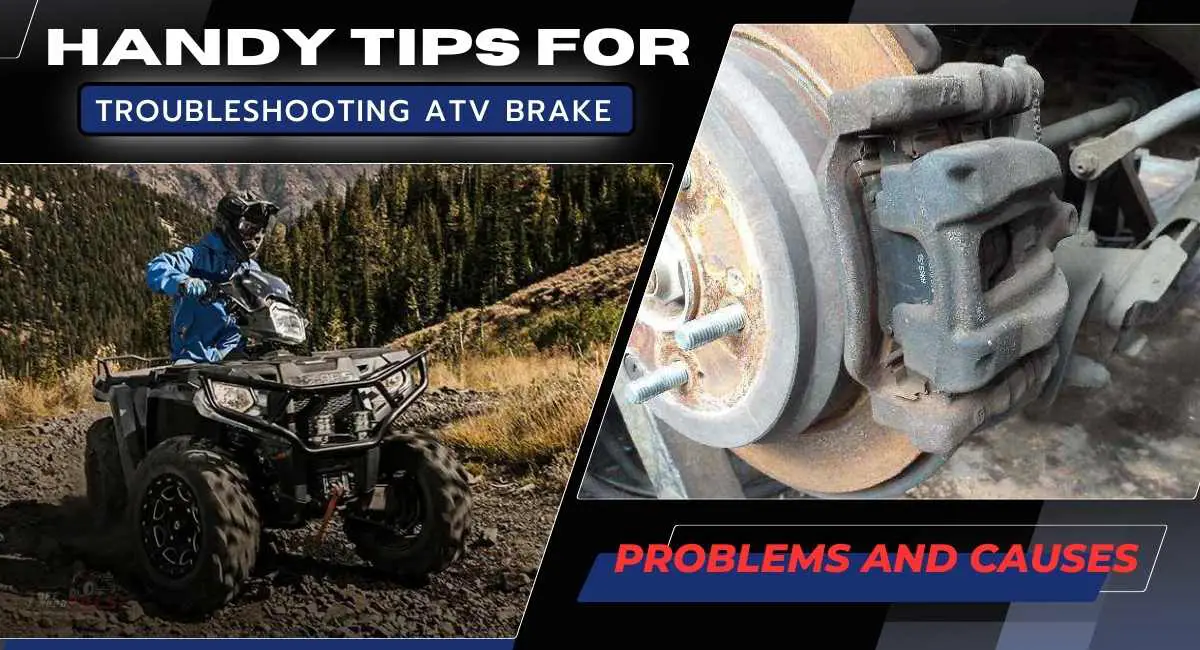The brake system is a mandatory feature in all-terrain vehicles, and it is for obvious reasons. This safety system is specially designed to keep riders safe and in control while navigating diverse terrains. Without reliable brakes, riding an ATV can quickly become a risky business.
However, it can get really frustrating when your brakes start to act up for no apparent reason. If you’re not an ATV expert, it can get pretty confusing when your ATV suddenly gives you trouble. The good news is that you can diagnose and fix the most common brake issues with a little know-how and some basic tools.
Common ATV Brake Problems
Every ATV requires a properly functioning brake system to avoid running into problems down the road. The braking system acts as your vehicle’s first defense mechanism, plus it helps your vehicle stop at critical moments. That said, here are some common ATV brake problems you need to be aware of;

Brake Noise
The most common dissatisfaction among ATV users is the braking system producing unusual noise at some point. If you notice a high-pitched squeak or squeal when you press your car’s brakes, it often serves as the first sign of the brake pads getting thin. The brake pads are equipped with a metal piece, and as they wear down, the metal piece contacts the brake rotor, creating a squeaky noise.
However, if you experience a loud grinding noise, it could be a more serious issue. This typically occurs when the brake pads are severely worn down, causing the metal backing of the pads to grind against the metal brake rotors directly. Occasionally, foreign objects in the caliper can also cause this noise, but worn-out pads are the usual culprit.
Brake Won’t Engage
The second common problem you’re likely to experience with your ATV is the brake pedal failing to engage the brakes. Finding yourself in a situation where your car won’t move because the brake isn’t disengaging can be frustrating and even alarming. Some of the common reasons why your brake may not engage or disengage properly include;
Poor positioning of brake shoes
If your brake shoes are not well positioned, they might fail to make proper contact, leading to issues with your parking brake. Adjusting brake shoes typically helps solve this issue, and it can involve removing wheels, warped or damaged rotors, or drums.
Broken/Detached/Frayed Cable
A damaged parking brake cable, whether broken, detached, or frayed, can cause the brake to fail to engage. Check that the cable is securely attached to both rear brakes for effective engagement.
Loose Cable
Generally, a loose nut can introduce slack in the cable, thereby preventing proper engagement. As such, ensure that any nuts attaching the cable are tightened securely.
Rust/Corrosion
Rust accumulation on the bell crank can make brakes fail to engage properly. Ideally, the rust hinders the movement of the bell crank or causes it to seize, which prevents the proper activation of the brakes.
Frozen Brake
Cold and wet weather conditions often make the parking brake freeze, which prevents engagement or disengagement. In such situations, you may want to take precautions, like parking in a sheltered area or using a block under the wheel to help prevent freezing.
Brake Pedal Issues
There is nothing as worrying as hitting the trails only to realize that your brake pedals are not working. Issues with the brake pedal often manifest as sponginess, stiffness, or a pedal that sinks to the floor. When this happens, your quad may give out some red flags to alert the rider that something is wrong.
Soft or Spongy Pedal
Whenever you press the brake pedal, it should offer a certain level of resistance for a firm response. However, if the pedal feels soft or spongy, it indicates a problem within the hydraulic parts of the brake system.
The soft sensation can feel like stepping on soft fruit, with the pedal easily going down, sometimes all the way to the floor. The problem can arise from several causes, including the presence of air in the brake lines, brake fluid leak, and worn-out pads and rotors.
Hard Brake Pedal
A hard brake pedal can indicate a lack of boost from the brake booster. The brake booster is a crucial component designed to make it easier to stop the ATV by amplifying the force applied to the brake pedal. If the brake pedal feels unusually hard to press, it suggests an issue with the brake booster. This can arise from multiple causes, such as a vacuum leak and a faulty brake booster.
Brake Fluid Leaks
Apart from faulty pedals, ATVs can experience brake fluid leaks, which are often a serious safety concern. Brake fluid leaks can stem from deteriorating seals in components such as the master cylinder, caliper, or wheel cylinder.
One common indication of a brake fluid leak is the presence of a puddle of fluid under your vehicle, usually near the wheels or directly under the brake pedal area. This fluid is often clear or slightly yellowish and has a distinct oily texture and odor.
Another sign of a brake fluid leak is a soft or spongy brake pedal. If air enters the brake lines due to the leak, it can cause the pedal to feel mushy or require more effort to depress. This occurs because air is compressible, unlike brake fluid, which can lead to decreased braking performance and longer stopping distances.
Brake Fade
Brake fade is often encountered in situations where brakes are subjected to heavy use, such as driving in hilly terrain or while towing heavy loads. The key characteristic of brake fade is a noticeable decrease in the responsiveness of the brakes.
Ideally, if the brakes heat up beyond their optimal operating temperature, the friction material on the brake pads may lose its effectiveness. This can lead to a situation where pressing the brake pedal requires more effort and longer distances to achieve the desired level of braking.
Warped Rotors
The main purpose of brake rotors is to help the brake pads slow down or stop the vehicle by creating friction when they press against them. Brake rotors are designed to be flat and smooth, which ensures consistent contact with the brake pads. However, they are susceptible to warping, especially with continuous use.
The primary cause of warped rotors is overheating. Excessive heat can lead to warping or deformation of the rotors. This overheating often occurs during heavy brake usage, such as when descending a steep slope for an extended period or when towing heavy loads. Additionally, uneven lug nut torque during wheel installation can also contribute to rotor warping.
A common symptom of warped rotors is a pulsating or vibrating sensation felt in the brake pedal or even the steering wheel when braking. This occurs because the warped rotor causes uneven contact with the brake pads, resulting in an irregular braking sensation.
Caliper Issues
Riding an ATV with damaged calipers can affect brake performance and lead to unsafe braking. As such, it is important to know the signs to look out for when it comes to the performance of the brake calipers. The primary concern with brake caliper is a seized caliper. This occurs when the caliper is unable to slide freely due to rust, dirt, or debris buildup.
When a caliper seizes, it impedes the proper movement of the brake pads, causing them to rub against the rotor constantly. The continuous friction leads to excessive and uneven wear of the brake pads and, consequently, warped rotors.
How to Troubleshoot ATV Brake Problems
Diagnosing and fixing ATV brake problems is paramount for ensuring safety and maintaining optimal performance during off-road adventures. The brake system serves as a critical safety feature, and any issues with it can compromise rider safety and control.
Visual Inspection
Start by visually inspecting the ATV’s brake components. Look for signs of damage, wear, or fluid leaks. Check the brake pads for thickness and even wear. Consider replacing any pads that appear excessively worn or damaged. Examine the brake rotors or drums for signs of scoring, warping, or uneven wear. Additionally, look for any debris or obstructions that may be affecting brake performance.
Check Brake Fluid Levels
Remove the reservoir cap and visually inspect the brake fluid level. Ensure the level is between the minimum and maximum markings. If the fluid level is low, add brake fluid to bring it to the appropriate level, using the type of brake fluid recommended by the manufacturer.
Examine Brake Pads and Rotors
Remove the wheels to access the brake pads and rotors. Inspect the brake pads for thickness and even wear. Check the brake rotors for signs of scoring, warping, or uneven wear. Make sure to replace any worn or damaged brake pads and rotors.
Inspect Brake Lines
Inspect the brake lines for leaks, cracks, or damage, paying close attention to the areas around fittings and connections. Use a flashlight to check for any signs of brake fluid leakage and replace any damaged brake lines or fittings.
Test Brake Pressure
Start the ATV and apply the brakes while stationary, and note any unusual resistance or softness in the brake pedal or lever. Test the brakes at low speeds in a safe, open area, paying attention to any vibrations, pulling to one side, or abnormal noises during braking. If the brakes feel spongy or lack responsiveness, bleed the brake system to remove air and restore proper hydraulic pressure.
Regular Brake Maintenance
Maintaining well-functioning brakes can mean the difference between a near-miss and a dangerous situation. With time, brakes naturally wear down, which diminishes their effectiveness. Regular brake system upkeep can help identify and address any issue before it escalates. Don’t wait until a problem arises- always prioritize preventive maintenance to keep your ATV safe and prepared for every ride.
Conclusion
Now that you’re aware of the most common ATV brake problems and how to troubleshoot them, the next step is to ensure that they are functioning properly and well maintained. Always stay vigilant with regular inspections and address any signs of wear or damage as soon as they appear. When all is said and done, investing your time and effort in brake maintenance will ensure your safety and peace of mind during your ATV adventures.




